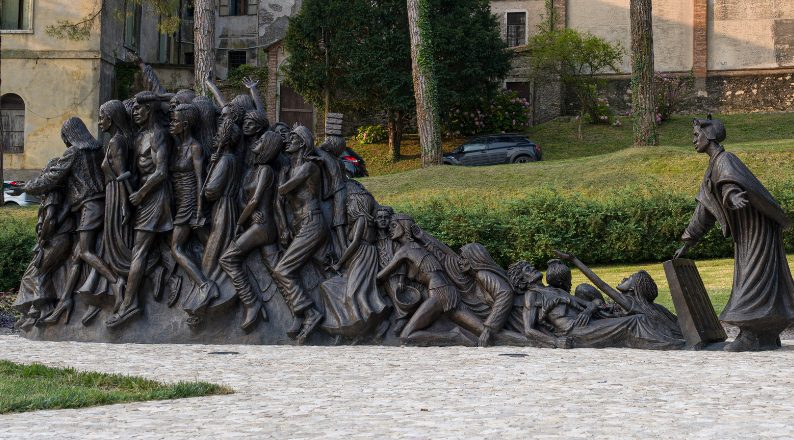(ZENIT News / Schio, Italy, 07.03.2023).- “Let The Oppressed Go Free” was inaugurated on june 29 in front of the Church of St. Francis in Schio, Italy, on the occasion of the feast of St. Peter the Apostle, patron saint of this city.
The Vatican Secretary of State, Cardinal Pietro Parolin, was in charge of blessing the sculpture by artist Timothy Schmalz, which evokes the figure of St. Josephine Bakhita with the intention of raising awareness of the problem of human trafficking.
During the blessing, Parolin – a native of the Italian province of Vicenza – said: «Seeing this work, one would think that people end up at the height of the trap door, but in reality they are still underground. If not all the people in the world, at least those of us who are here can see ourselves represented in this sculpture because I believe that we all have a slavery from which we must free ourselves.”
In front of the new sculpture, the Cardinal invited everyone to «ask St. Bakhita, who is the patron saint of victims of trafficking, to help us free ourselves from this slavery. And do you know what that is? It is closing ourselves off. The individualism that prevents us from caring for others as we should. Pope Francis continues to make an appeal about this, about the indifference with which we look at the reality of our day, of our days, especially, the reality of suffering, pain, and vulnerability. Only if we free ourselves from this slavery will we truly be able to help others.»
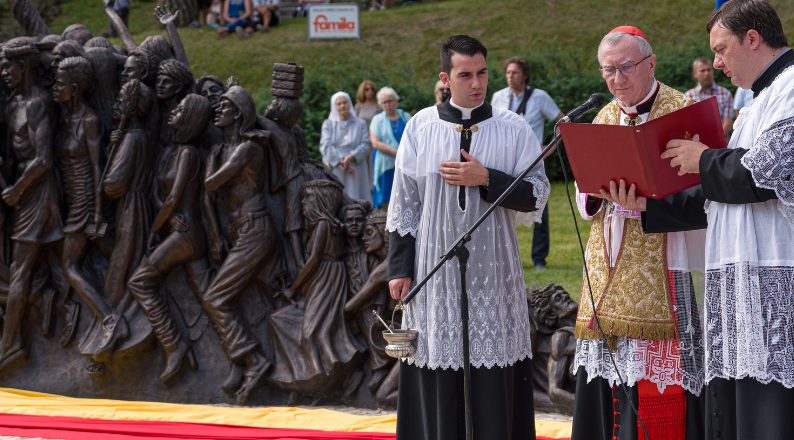
Schio, the city of Saint Bakhita
The place chosen for the installation of the sculpture was Schio, the town where Saint Josephine Bakhita, patron saint of victims of trafficking, lived and died.
The Mayor of Schio, Valter Orsi; the benefactor of the work and President of the Rudolph P. Bratty Family Foundation, Christopher Bratty; the creator of the sculpture, Canadian artist Timothy Schmalz; the Superior General of the Canossian Daughters of Charity, Sister Sandra Maggiolo, FdCC; the International Coordinator of Talitha Kum, Sister Abby Avelino; the parish priest, moderator of the St. Bakhita Pastoral Unit: Monsignor Carlo Guidolin; and the president of the Bakhita Schio-Sudan Association, Gianfrancesco Sartori; led the unveiling ceremony of “Let The Oppressed Go Free”.
In front of nearly a thousand people who participated in the homage to Saint Bakhita, the Arcangelo Michele de Schio choir was in charge of opening the ceremony while the veil with Schio colors (yellow and red) that covered the sculpture was removed. After Cardinal Parolin’s blessing, the G.E.S. choir – directed by Marco Manzardo – sang two songs while the public left in procession from the Church of St. Francis to the Cathedral of St. Peter of Schio where the central mass was celebrated.
Yesterday, during the General Audience, Pope Francis had a touching conversation with Schmalz and the president of the Rudolph P. Bratty Family Foundation, Christopher Bratty, about the legacy of Saint Bakhita. After the meeting, His Holiness blessed a miniature version of the sculpture made with a 3D printer that was brought to him by the artist and the benefactor of the work.
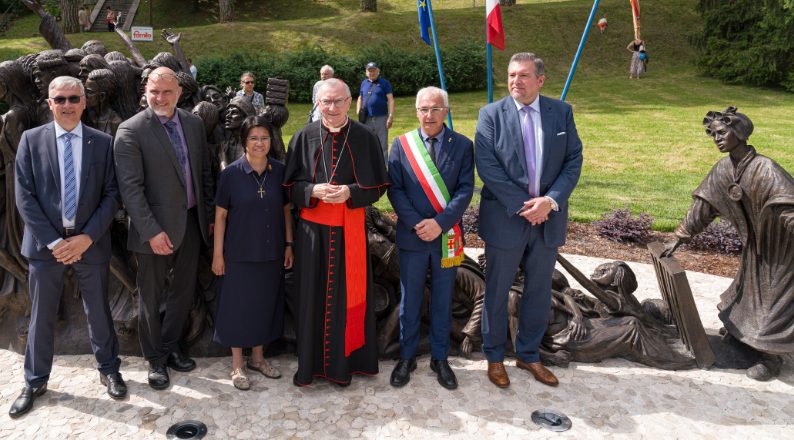
A problem beneath the surface
“Let The Oppressed Go Free” is inspired by a passage from The Bible (Isaiah 58:6), from which Schmalz takes the name of his work: “This is the fast that I love – oracle of the Lord: to loose the unjust chains, to untie the bonds of the yoke, to let the oppressed go free, and to break all yokes.”
Every February 8, on the occasion of the feast of St. Josephine Bakhita, the Church celebrates the World Day of Reflection and Prayer against Human Trafficking. In the last edition, Pope Francis emphasized that the vulnerable populations most seriously exposed to suffering this crime are “people impoverished by the economic crisis, wars, climate change, and so much instability is easily recruited”. In this sense, he encouraged to “seek ways to transform our societies and prevent this shameful sore that is human trafficking”, which he described as a «dark phenomenon».
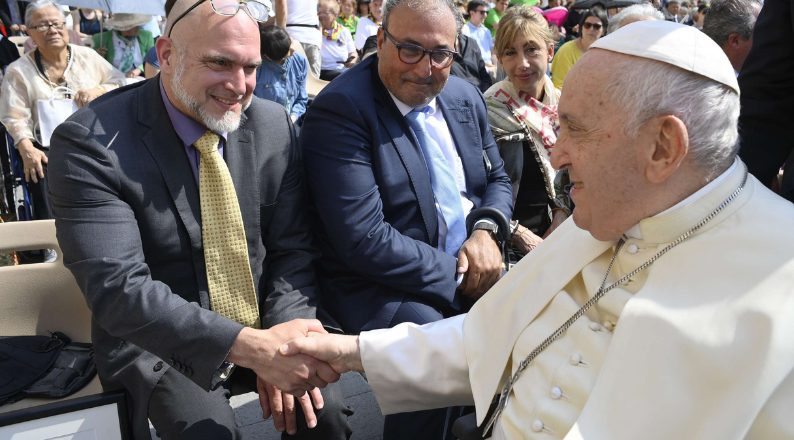
A sculpture to raise awareness
Schmalz’s sculpture displays St. Josephine opening the lid of a manhole from which emerge figures representing the various forms of trafficking that exist in the world. In line with the words of the Holy Father, the artist seeks to point out that the problem of trafficking will continue to exist as long as we keep it in the dark.
Measuring 6 meters long, 1.2 meters wide, and 2.4 meters high, “Let The Oppressed Go Free” was made thanks to the financial contribution of the “Rudolph P. Bratty Family Foundation«, belonging to a family of immigrants from northern Italy.
The sculpture in Schio is the original, but other replicas already exist, such as the one blessed by the Cardinal and Archbishop of New York, Timothy Dolan, at St. Patrick’s Cathedral (New York, USA) in October last in October last year, or the one that will be installed at Regis College in Toronto (Canada) during the month of July.
This sculpture maintains a relationship with «Angels Unawares«, another outstanding work by Schmalz installed in St. Peter’s Square, in Rome, and which was blessed by Pope Francis in 2019. In both works, the Canadian artist speaks of human vulnerability: in «Angels Unawares» the tragedy and helplessness suffered by refugees is highlighted, while in «Let The Oppressed Go Free» Schmalz seeks to make the problem of human trafficking visible.
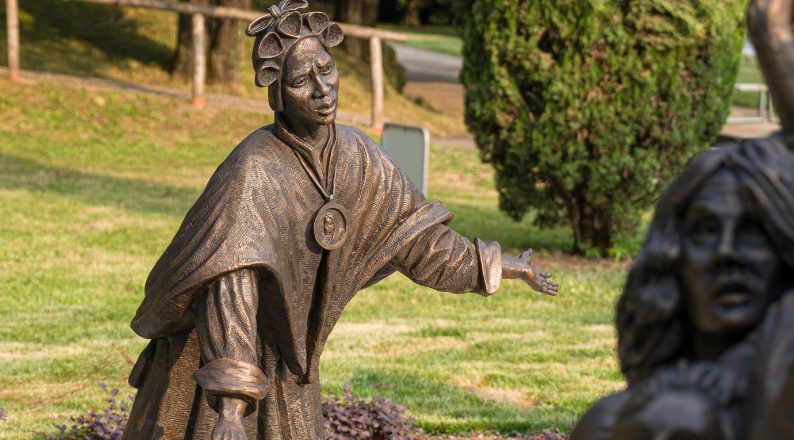
Human trafficking, a global problem
One in five victims of human trafficking are children worldwide. Those living in the poorest regions and sub-regions, such as Africa and the Greater Mekong, make up the majority of trafficked persons, while women account for two-thirds of the world’s human trafficking victims.
According to the United Nations Office on Drugs and Crime, human trafficking is one of the most lucrative illicit businesses in Europe, with criminal groups making profits of US$3 billion a year, a substantial business that preys on the world’s most marginalized population.
The Global Report on Trafficking in Persons 2022 – also produced by the United Nations Office on Drugs and Crime – indicates that war and conflict increase the number of victims inside and outside crisis zones, providing opportunities for criminals to exploit. Meanwhile, another finding from the report indicates that climate change also multiplies the risks of human trafficking, as displacement by natural disasters increases the vulnerability of people in situations of poverty, leading them to seek or accept jobs they would not traditionally take in order to survive. Within the Catholic Church, the Talitha Kum network (UISG) works against human trafficking by actively supporting victims, survivors, and people at risk around the world.


